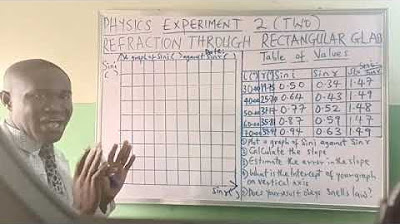Refração da luz: Índice de refração absoluto. 1/4
Summary
TLDRThis video explains the concept of light refraction and the refraction index. It clarifies that refraction occurs when light passes from one material to another, causing a change in speed, and sometimes direction. The speaker addresses common misconceptions, explaining that refraction does not always involve a change in direction. The index of refraction is introduced as a measure of the light's speed in different materials, with emphasis on its dependency on both the material and the color of light. The lowest possible refractive index is 1, which represents a vacuum. The speaker also touches on the concept of refractive materials, which have higher refractive indices.
Takeaways
- 😀 Refraction occurs when light moves from one material to another with different optical properties, causing a change in speed.
- 😀 A common misconception is that light always bends during refraction, but sometimes it may not change direction at all.
- 😀 Every time light undergoes refraction, reflection also occurs simultaneously.
- 😀 Refraction is characterized by a change in material and speed, but it doesn't always result in a change in direction.
- 😀 The refractive index (n) is the ratio of the speed of light in a vacuum (c) to the speed of light in a material (v).
- 😀 The refractive index depends on both the material and the color of light passing through it.
- 😀 Different materials (e.g., glass, water) have different refractive indices depending on the color of light (e.g., blue, red).
- 😀 The smallest possible refractive index is 1, which occurs in a vacuum where light travels at its maximum speed.
- 😀 A refractive index less than 1 is impossible because light cannot travel faster than in a vacuum.
- 😀 The term 'more refringent' refers to a material with a higher refractive index, meaning it bends light more.
Q & A
What is refraction of light?
-Refraction occurs when light passes from one material to another and changes its speed, possibly altering its direction.
Can refraction of light always lead to a change in direction?
-No, refraction does not always result in a change in direction. The light may refract without changing its path.
Does light always reflect when it refracts?
-Yes, whenever light refracts, it also reflects. This is an important characteristic of light's behavior during refraction.
What is the refractive index, and how is it calculated?
-The refractive index (or index of refraction) is calculated by dividing the speed of light in a vacuum by the speed of light in a given material.
What factors influence the speed of light in a material?
-The speed of light in a material depends on the material itself and the color (wavelength) of the light passing through it.
Why does the refractive index depend on both the material and the color of light?
-The refractive index depends on the material because different materials have different optical properties, and it depends on the color because different wavelengths of light travel at different speeds in a material.
What is the minimum possible refractive index?
-The minimum refractive index is 1, which occurs in a vacuum. This is because the speed of light in a vacuum is the fastest, and dividing it by the same speed results in 1.
Can the refractive index be less than 1?
-No, the refractive index cannot be less than 1 because it would require a medium where light travels faster than in a vacuum, which is not possible.
What does it mean if a material is described as more refringent?
-A more refringent material is one with a higher refractive index, meaning light travels slower in that material compared to other materials with lower refractive indices.
How does the refractive index of a material vary for different colors of light?
-The refractive index of a material can vary for different colors of light. For example, glass has different refractive indices for blue light, yellow light, or red light.
Outlines

Cette section est réservée aux utilisateurs payants. Améliorez votre compte pour accéder à cette section.
Améliorer maintenantMindmap

Cette section est réservée aux utilisateurs payants. Améliorez votre compte pour accéder à cette section.
Améliorer maintenantKeywords

Cette section est réservée aux utilisateurs payants. Améliorez votre compte pour accéder à cette section.
Améliorer maintenantHighlights

Cette section est réservée aux utilisateurs payants. Améliorez votre compte pour accéder à cette section.
Améliorer maintenantTranscripts

Cette section est réservée aux utilisateurs payants. Améliorez votre compte pour accéder à cette section.
Améliorer maintenantVoir Plus de Vidéos Connexes

A Lei de Snell Explicada (Como a Refração Funciona?)

Refraction and Snell's law | Geometric optics | Physics | Khan Academy

Answering viewer questions about refraction

REFRAÇÃO DA LUZ | MAPA MENTAL | QUER QUE DESENHE? | DESCOMPLICA

2nde - La réfraction

How to get your readings without touching any apparatus
5.0 / 5 (0 votes)
